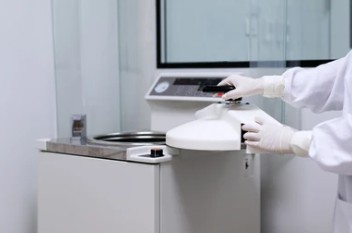Media Preparation and Sterilization

Using mother liquor to prepare medium can not only improve work efficiency, but also reduce weighing errors of substances with very small amounts. The medium contains a lot of organic matter, especially the high sugar content, which provides an excellent place for the growth and reproduction of various microorganisms. Therefore, it is necessary to sterilize the medium to ensure the smooth progress of plant tissue culture. The method of sterilization of solid medium generally adopts high pressure steam sterilization.
Procedures
A. Medium Preparation (take the preparation of 500 mL MS medium as an example)
- Take a 500 mL volumetric flask for each group, and use a 50 mL graduated cylinder to take 50 mL of the mother liquor of macroelements. Then use a pipette to draw 5 mL of trace element mother liquor, 5 mL of organic matter mother liquor, 2.5 mL of iron salt mother liquor, and hormone mother liquor (the concentration of which is temporarily determined) into a 500 mL volumetric flask (note: pipettes cannot be mixed). Weigh 15 g of sucrose into a 100 mL beaker, dissolve it with deionized water, pour it into a 500 mL volumetric flask, set the volume to 500 mL, and then pour it into a 500 mL beaker for pH adjustment.
- After the pH meter was calibrated, the pH of the medium was adjusted to 5.8 with 1 mol/L NaOH or 1 mol/L HCl. When preparing, use a glass rod to stir continuously.
- Weigh 4 g of agar and pour it into the medium whose pH has been adjusted. Then put the beaker in boiling water for digestion, and stir it with a glass rod when cooking. After the agar melted, use a 10 mL graduated cylinder to distribute the culture medium into 50 mL Erlenmeyer flasks, about 10 mL per bottle. Seal the bottle with sealing paper and a rubber sleeve, and write the culture medium code on the paper, ready for autoclaving.
B. Medium Sterilization
Put the subpackaged culture medium into the sterilization barrel of the autoclave, add water to the outer layer of the pot, the water level does not exceed the height of the pillars, cover the pot, and install the screws. After heating, the pressure gauge pointer on the pot starts to move. When the pointer moves to 0.5 kgf/cm2, unscrew the air release valve to discharge cold air and return the pointer of the pressure gauge to zero. Close the deflation valve and continue heating. When the pointer moves to 1.1-1.2 kgf/cm2, keep the pressure for 14-20 minutes (at 122-124°C), and the purpose of sterilization can be achieved.
When using a high-pressure steam sterilizer, the following two points should be paid attention to:
- The cold air in the pot must be exhausted to ensure the sterilization effect. Otherwise, although the pointer of the pressure gauge points to a certain pressure, due to the existence of cold air in the pot, the required temperature cannot be reached, and it is difficult to achieve complete sterilization.
- When a certain pressure is reached, the sterilization time must be strictly observed. If the time is too long, some chemical substances will be destroyed and affect the composition of the medium. If the time is short, the purpose of complete sterilization cannot be achieved.
For research or industrial raw materials, not for personal medical use!
